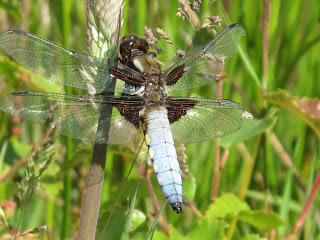I haven't seen any of the chasers for the last two weeks. Last year, after clashes over the pond it was clear that there was only room for one male broad-bodied chaser, (an example of the male the Libellula Depressa is pictured above). This year we have had two apparently content to occupy different parts of the bank.
This may be due to the higher levels of the vegetation at the edge of the pond, meaning that there are more perches to choose from, or because there are more females in the neighbourhood -- I have seen several in the long grass behind the pond (home-grown like the one that died and which was the subject of a blog last month).
Whatever the reason, it was wonderful to see them back.
This week saw the return of the hawkers. The girls swear an emperor has visited, but all I've seen is this rather small but beautiful common sympetrum (at least, that's what I assume it is, it's the first I've seen).
Paul Glendinning's Blog: ponderings on mathematics and life in the pond at the bottom of my garden.
Saturday, 30 July 2011
Tuesday, 5 July 2011
Newton's Cradle Revisited
The next View from the Pennines looks at some fairly recent work on visco-elastic collisions based on Newton's cradle. This is an executive toy with five (or so) ball-bearings hanging from a frame so that they line up perfectly when hanging down. If one of the end balls is lifted back and released it makes a pendulum swing, strikes the line and an impulse is instantaneously propagated along the line to the other end, and that ball swings up and the cycle repeats.
That is the standard physics textbook explanation anyway, and of course it is wrong! Experiments show that all the balls move a little and there is a complicated long term evolution of the behaviour.
As part of the article I made a simple model to deal with the three halves power law of the (Hertzian) interactions of the balls whilst in contact, with a simplifying assumption that the time of interaction is constant (I had to beg an extra day from the IMAs patient editor, Rebecca Waters to make the calculation). Of course, no sooner had I sent off the final version than I realized that -- almost certainly (I haven't checked the details) -- my analysis is much more accurate than I had thought and the 'assumption' is in fact completely justified.
I'll have to go through it more carefully, but if true it provides a nice example of a hybrid system for which it is possible to obtain an exact return map without being able to solve for the full details. One unknown parameter is introduced, but the quantitative details are pretty much independent of this parameter anyway!
This peachy version of Newton's Cradle is from Caroline Savva's website:
http://carolinesavva.blogspot.com/2011/06/newtons-cradle-revisited.html.
It makes me smile.
That is the standard physics textbook explanation anyway, and of course it is wrong! Experiments show that all the balls move a little and there is a complicated long term evolution of the behaviour.
As part of the article I made a simple model to deal with the three halves power law of the (Hertzian) interactions of the balls whilst in contact, with a simplifying assumption that the time of interaction is constant (I had to beg an extra day from the IMAs patient editor, Rebecca Waters to make the calculation). Of course, no sooner had I sent off the final version than I realized that -- almost certainly (I haven't checked the details) -- my analysis is much more accurate than I had thought and the 'assumption' is in fact completely justified.
I'll have to go through it more carefully, but if true it provides a nice example of a hybrid system for which it is possible to obtain an exact return map without being able to solve for the full details. One unknown parameter is introduced, but the quantitative details are pretty much independent of this parameter anyway!
This peachy version of Newton's Cradle is from Caroline Savva's website:
http://carolinesavva.blogspot.com/2011/06/newtons-cradle-revisited.html.
It makes me smile.
Subscribe to:
Comments (Atom)


